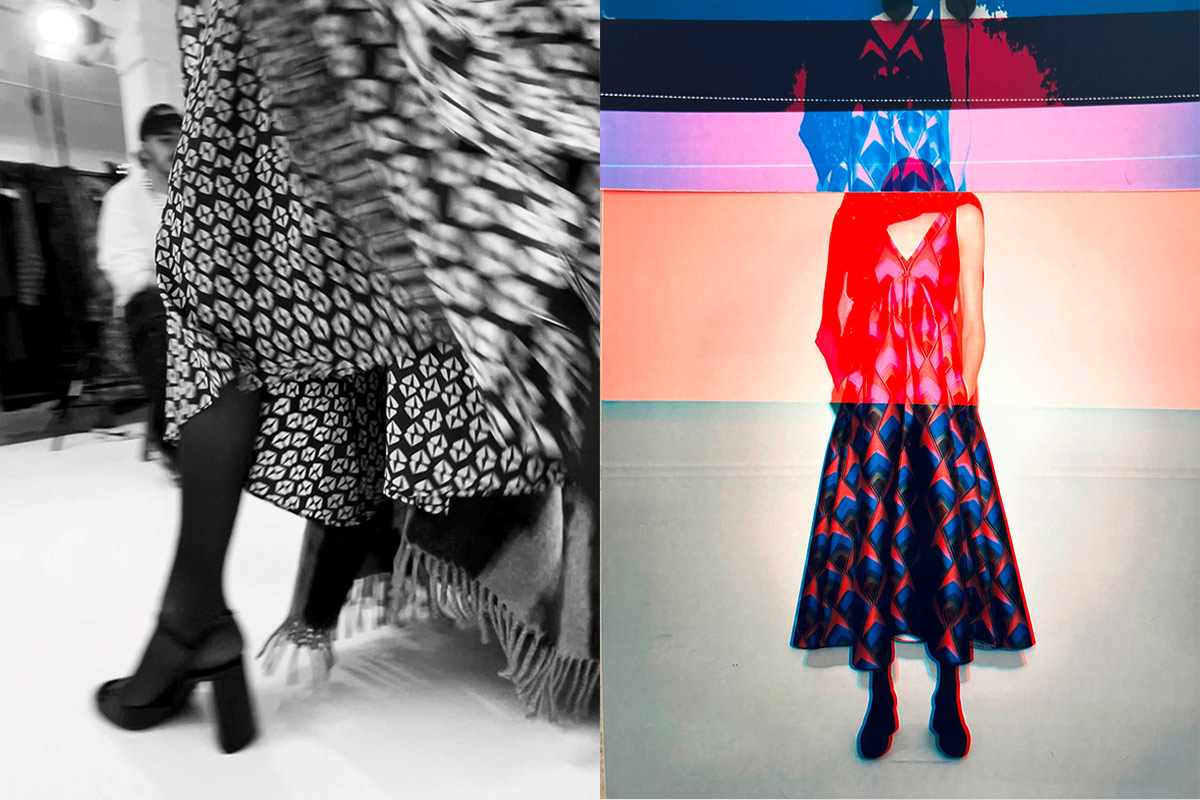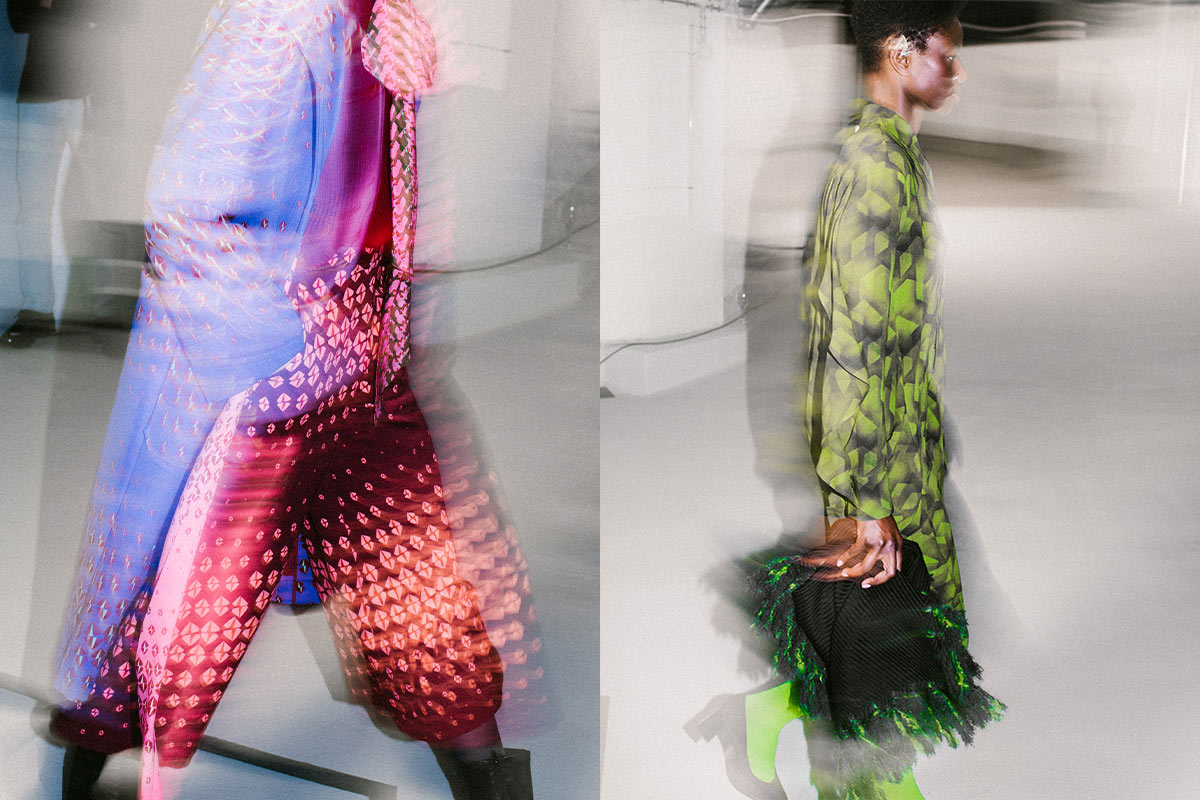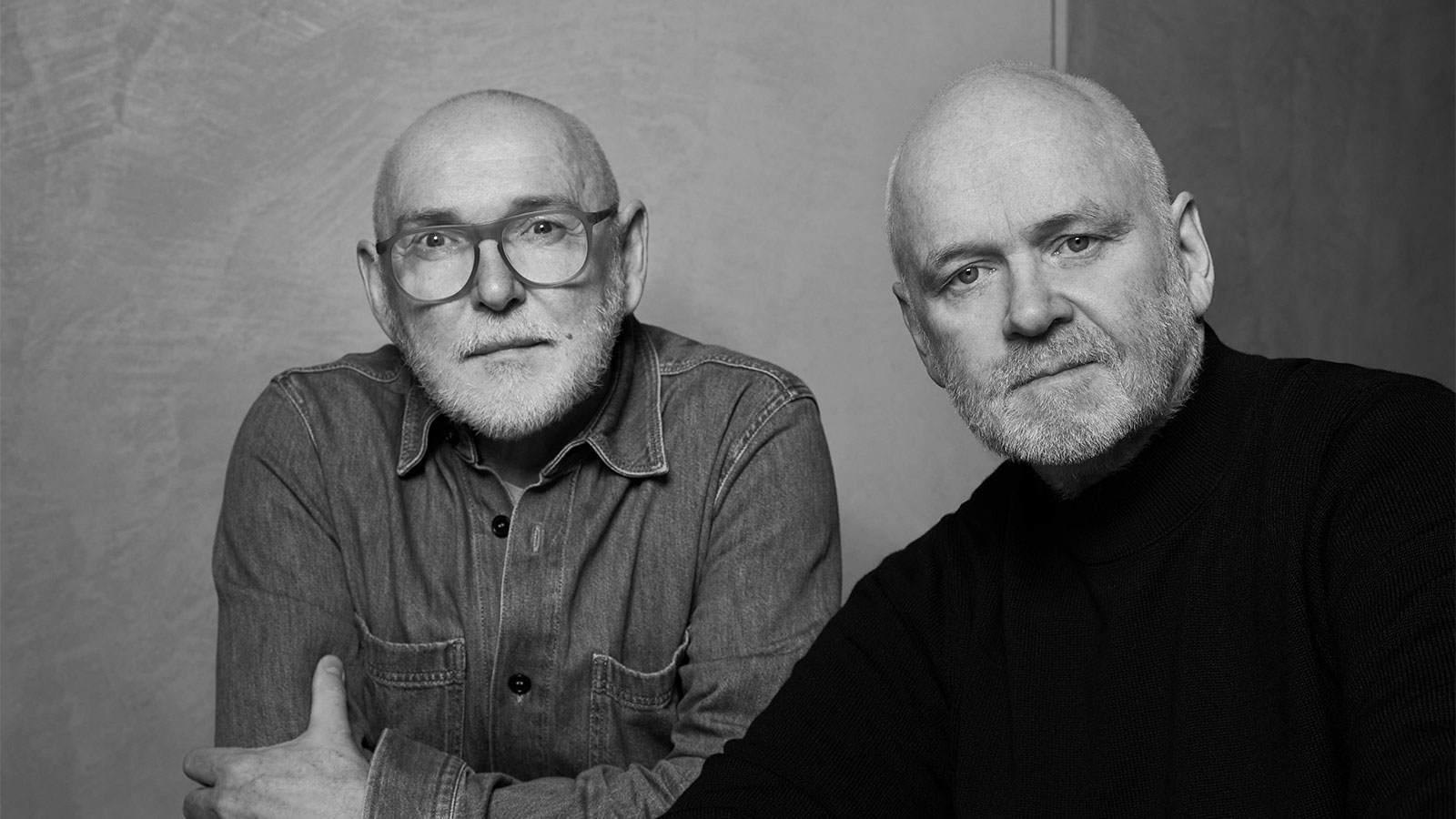Spontaneous ideas are usually the best. In the case of Otto Drögsler and Jörg Ehrlich, it was precisely this flash of inspiration that led to the founding of their own label, Odeeh. Since then, the duo has been as much a part of Berlin as the Alex or Berghain. The years pass, the fashion industry changes – but Drögsler and Ehrlich’s passion for textiles, good cuts and the catwalk remains.
FACES: Too many cooks spoil the broth. How do you always manage to find a consensus between the two of you?
Otto Drögsler & Jörg Ehrlich: Sometimes many cooks are good, so that not everything tastes the same. At least that’s how we would describe it in terms of our working principle.
F: Which discussion between you has been the most annoying so far?
OD & JE: Always the last one, as long as it was a real confrontation. We always discuss the important things very passionately, but we know from experience that we and Odeeh always put up with it.
Everyday life as a designer
F: Draw an unembellished, realistic picture of everyday life as a designer!
OD & JE: We are both designers AND entrepreneurs. And it is in this permanent ambivalence that our everyday life and work on the collection and the ongoing development of Odeeh takes place. But everyday life is certainly much less glamorous than we often imagine. If you can talk about everyday life at all.
F: What is your favorite moment in the production process of your collections?
OD & JE: Actually the real beginning. In other words, the moment when we start thinking and define the first guidelines in an ideal and abstract way. And then again this final phase, which is all about the styling and the final statement of the collection. Everything in between is really hard work.
What’s behind the label name Odeeh
F: What does your label name actually mean?
OD & JE: Odeeh is a mix of letters from our respective names: OD for Otto Drögsler. An E in between for a Latin AND. And then the EH for Jörg Ehrlich’s surname.
F: You once said that creation always requires time pressure, chaos and excessive demands. Do you create these conditions through tight deadlines and how do you manage not to get lost in the chaos?
OD & JE: Chaos and excessive demands can contain something fundamentally good, at least as we understand it when it comes to the collection process. Drawing board timings quickly provoke only the familiar. Chaos and uncontrolled phases in the creation of a collection get us out of the box of “this is how we always do it” thinking. Without excessive demands, you don’t become a winner, but rather an administrator of the status quo.
F: Is this approach perhaps also due to the fact that you guys built Odeeh back during the financial crisis?
OD & JE: Good thought, could be. That has probably shaped us. But it’s certainly also the fact that we’ve been doing all of this for quite some time and were able to gain a lot of experience in the so-called “industry” before Odeeh. One thing is certain: you need a hell of a lot of resilience and energy to survive in this industry.

Of creative corsets and rebellion
F: You say you don’t work with a mood board so as not to restrict yourselves. Don’t the history of Odeeh and your expectations and those of your consumers nevertheless create a creative corset in one form or another?
OD & JE: Oh, we wouldn’t want to call it a corset, that sounds so restrictive, breathless and rigid. We see the history of Odeeh, our customers and everything we have already done more as a guardrail to guide us. At the same time, however, you always have to make room in your brain for the new portion – the unexpected, perhaps the blank spot of Odeeh that needs to be discovered. Too much DNA fulfillment is never good.
F: With your approach to your collections and to fashion, do you also see yourselves as rebels?
OD & JE: That’s for others to judge, we wouldn’t make that description for ourselves. But if someone were to say it about us: It would be more of a compliment to our ears.
F: You say there are many different ways of interpreting Odeeh. Is that the key to being successful with your sometimes very different looks?
OD & JE: I hope that’s the case! We perceive ambiguity, complexity and visual contradiction as something extremely positive. We make fashion, and fashion thrives on change and individuality. We don’t want to lecture, we want to suggest something. The woman who buys something from Odeeh is always right with her own interpretation of it, no matter how we feel about it.
F: What is most important when sourcing new materials and fabrics; do you always work with the same manufacturers, or how do you discover new ones?
OD & JE: There is a core group of weavers with whom we have been working from the very beginning. These make up around 40 to 50 percent of our producers, the rest are constantly changing. This formula has proven itself over the years and ensures both poles: stability and change.
The fashion industry is changing
F: What has changed in the fashion industry since you founded Odeeh in 2008 that you’re happy about, and what new development don’t you like at all?
OD & JE: We are rather humble when it comes to change and are just as happy about the principle of change and renewal as we are when certain factors remain constant. We do not comment on change. In principle, we would say: everything is fine. This is not a superficial attempt to avoid the question, but rather describes the attitude that we rely on the fact that the sensible always prevails and the stupid, senseless somehow disappears again anyway.
F: Are you dreading the future or looking forward to it?
OD & JE: We are looking forward to it. With a lot of respect.
F: The fashion industry is often criticized. Is seasonal and trend-independent unisex fashion the way to go?
OD & JE: The seasonal thing has somewhat disappeared from most people’s minds anyway. And if, like us, you work for different climatic zones, then the idea of clear summer or winter collections becomes a little less important anyway. But still: I need a heavy coat more in December and less in June. As our most important markets are Northern Europe, the USA, Canada and Japan, there will always be certain focal points. But still: we all buy not because we have a real need, but because we want something. It’s about wanting something, an emotional level, less about the question: I need an umbrella because it’s raining outside.
F: Does the shift away from thinking about seasons, trends, key looks and it-pieces unsettle you?
OD & JE: No, not at all, on the contrary. It’s all rather liberating.
Sustainable fashion consumption?
F: Anyone who looks at fashion in our bubble gets the impression that sustainability and sustainable fashion consumption are actually on the rise. If you look beyond the horizon and look at the sales figures of Inditex, Shein and co, you could just cry. What needs to happen to stop the gap widening and make global fashion consumption truly sustainable?
OD & JE: Global consumption will only become more sustainable if this sustainability is and becomes affordable. Fortunately, we are at a point where fashion is no longer elitist and you only get tasteless stuff at the lower end. If you want to, you can dress very well with little money – that’s a good thing for a start. Many of the big players are also moving in this direction. Let’s not kid ourselves: When Inditex develops sustainability programs, it may have more impact and effect than when smaller labels do so. In the end, the customers decide what is produced. But the fact is that there will remain a certain ambivalence when it comes to these questions, which we will have to endure. The real, true alternative would be: don’t buy anything at all. And that cannot be the idea; far too many livelihoods depend on our system. You can regret, criticize, whatever. But it is a fact.
F: Fashion shows used to be reserved for a small circle and were primarily important for buyers and journalists, but today they are real entertainment spectacles and a celebrity hotspot. Is this even necessary, and what do you think of this development?
OD & JE: We observe that both exist. And every designer, every label, every brand has to ask itself the question: What suits me? As far as Odeeh is concerned, we would always say that our shows are aimed more at the specialist audience, because this is where the decisions are primarily made about what to buy for the stores. At the same time, however, we also sense the relevance of a show that goes beyond this. Somehow, both are good and probably inseparable today. Nevertheless, as a brand you have to prioritize what you want first and foremost.
F: The concept of luxury has changed considerably. What does it mean to you personally, and should fashion generally be seen as a luxury?
OD & JE: For us personally, luxury is primarily about non-material things. Spending time with friends, being at home, having time, being generous and being able to afford something of great quality: All of this comes to mind when we think of ourselves and this concept. Luxury today is very individual. For us, it’s certainly about something handcrafted, perhaps something limited. For some it’s a day at the spa, for others a glass of champagne and for others a cashmere coat or a designer belt that is mass-produced. Both are possible, both are fine. Everything is right if it is right for the person who sees it that way.
F: Has it become more stressful to design fashion or, on the contrary, perhaps even easier?
OD & JE: It has become easier for us, as strange as that may sound. But it’s really a mental thing. You shouldn’t give it too much weight and importance. Then everything retains a lightness without becoming careless.
F: Do you see your many years of experience as an advantage over young colleagues in being able to approach your work in a more relaxed way?
OD & JE: We only know ourselves and the path we have taken so far. But we are glad to have this experience behind us. Experience, if you take it into account in doses in everything you do, can be infinitely helpful.

Fashion can do anything!
F: What can fashion do, what is it allowed to do, and what must it be?
OD & JE: First of all, fashion can be anything, really anything – and that’s exactly what it has to be, anything can happen. We find these do’s and don’t lists terrible. We have to visually endure everything that arises from this free attitude – whether we personally like it or not.
F: Odeeh is colorful, opulent, playful. Can you understand minimalists?
OD & JE: We would rather describe ourselves as colorful, being colorful would be too arbitrary for us. We allow ourselves to be a little bit of everything when we feel like it – why should we restrict ourselves? Sometimes we are also minimalist. Sure, we definitely understand minimalists. However, we find that minimalism and this quiet-luxury idea always come across as so moralistic and prudish. According to the motto: We do it better, we are more sustainable because we are more discreet. Well-made minimalism is the greatest thing of all. But something minimal has to be really on point, otherwise it is simply banal and visually poor. Minimalism is not a value in itself, but an aesthetic principle that is often used and misused as “the better way”. That might bother us.
F: After so many years in the business, don’t your imagination and creativity run out at some point?
OD & JE: No. Imagination is not a finite resource, but rather a principle that you want to live with. This is a fundamental decision, not a box that gets emptier the more you put in it.
out.
F: Escada, Rena Lange, Karl Lagerfeld, Chloé and René Lezard are lined up in your CVs. Founding your own label was your liberation, you once described it as “high-end freestyle” – do you still see it that way today, and could you imagine working for another fashion label again?
OD & JE: “High-end freestyle” is still the right word. We would still write the same today. And it’s nice to have this question reflected on again, because it reminds us of our start and makes it clear that we have remained very true to ourselves in this respect. As for other labels: why not? Odeeh always has priority, that is clear, but in the past few years we have
We have worked on many parallel projects over the years, and that has always been enriching for both sides.
Out of fashion
F: Can you imagine turning your back on the fashion industry? What would you do instead?
OD & JE: To be honest, we don’t ask ourselves that question. But if that was the case: One (Otto) would certainly be in the garden a lot, the other (Jörg) would spend a lot of time with Interior.
F: You are often seen in monochrome and very classic looks. So you fit the cliché of the designer in the black turtleneck sweater. How do you explain this phenomenon of creative people often wearing very muted colors and basics in their private lives?
OD & JE: We need a certain visual neutrality in everyday life. If, like us, you spend a lot of time thinking about colors, patterns, silhouettes and prints, then your own dark blue shirt can be a great help.
F: How do you separate your private life from the catwalk? Can you even do that?
OD & JE: Of course we can. It would be bad if not. We live in the provinces, have a large garden there, travel a lot and host our friends in the countryside at the weekend. We do not see ourselves as victims of this industry and can do otherwise – fortunately!
F: How do you train your resilience?
OD & JE: You develop them in your daily work, you can’t learn them in seminars or acquire them theoretically. The more that has gone wrong and the more you have been able to correct it, the stronger you are for the next time.
F: What do people do to make you happy?
OD & JE: With rare historical rose bushes, homemade postcards or self-painted souvenir pictures – there’s a lot, the main thing is personal. We are especially happy when our neighbor brings us homemade cakes on Sunday afternoons.
ODEEH
Karl Lagerfeld and Jil Sander were Otto Drögsler’s teachers. Together with Jörg Ehrlich, he later worked as Creative Director at René Lezard before the two of them founded the joint fashion label Odeeh in 2008 after a flash of inspiration. The two have now been creating colorful and clever designs for Odeeh for 15 years and are just as enthusiastic about it today as they were on the first day.
You can find all the news and great collections from Odeeh here.
You can find even more interviews with inspiring people here.
Teaser photo & photos: © Odeeh









